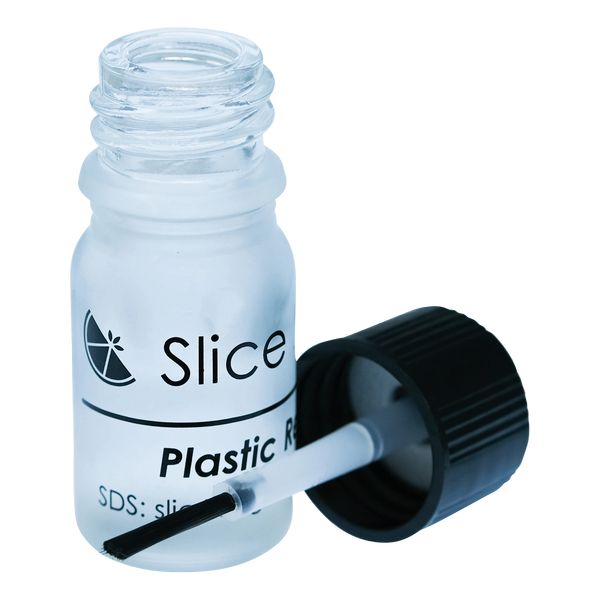
We found out a lot more about Slice Engineering’s new plastic repellent paint.
As a 3D printing accessory, this paint is certainly unusual. It’s a special concoction that is to be applied to your FFF hot end and the intention is to prevent a certain type of printing disaster.
3D Print Globs
That disaster occurs when a print dislodges from the build plate and gets stuck to the hot nozzle. While it’s being dragged around uselessly by the unknowing 3D printer, thermoplastic continues to extrude, collecting at the hot end. Eventually when the job completes your hot end is safely encased in an impenetrable mass of expensive thermoplastic. In the worst case, you’ve pooched your 3D printer.
Plastic Repellent Paint
Slice Engineering’s plastic repellent paint overcomes this by providing a non-stick coating to the metal portions of the hot end. This should make it far easier to remove plastic globs when they occur by re-heating and pulling them off.
In my previous story on this unusual paint, I pondered whether the paint contains PTFE. This substance, also known commercially as Teflon, has the unfortunate property of off-gassing at high temperatures, which is toxic to birds and has some nasty irritations in humans, too. If a 3D printer operator were to accidentally heat a painted hot end to a sufficiently high enough temperature, then this could happen.
I was contacted by Daniel Barousse, the CEO & Co-Founder of Slice Engineering, who provided quite a bit more detail on the product.
PTFE Paint Safety
Barousse explains that there is PTFE in the paint, but it’s engineered for high-temperature use:
“Plastic Repellent Paint does indeed contain PTFE (commonly known as Teflon). Specifically, it contains long polymer chain nanoparticles suspended in an aqueous (water) solution. This long chain version of PTFE is similar to what is found on your frying pan at home, but is unlike the short polymer chain version that is used to manufacture PTFE tubing. The chain length affects the temperature stability of the product — the longer the chain, the higher the temperature stability. Thus the reason that PTFE lined hotends are typically limited to low-200° C ranges, your modern frying pan at home routinely reaches the mid-200° C range, and our Plastic Repellent Paint is rated to 290° C.”
Barousse answered the question of what happens when the paint is exposed to temperatures higher than 290C:
“Plastic Repellent Paint is mostly water (>95% by volume). When it is applied to a surface, most of the water evaporates after 30-60 seconds, leaving behind a uniform layer of PTFE nanoparticles. As the temperature of the surface is raised PTFE reacts like a liquid — the molecules are excited and small fractions of them break their bonds, become gaseous and leave the surface. This is similar to what happens to water before it boils — the surface of the liquid becomes more ‘excited’ and the vapor pressure (number of molecules leaving the surface) increases. Continuing to increase the temperature will increase the fraction of molecules that leave the surface. When you hit 290° C the curve flattens out, leaving behind approximately 15% of the original PTFE nanoparticle layer. The remaining layer still has plastic repellent properties, and will endure indefinitely at 290° C or below, but will be somewhat less effective than a new coat. Above 300° C the PTFE will begin to break down into smaller molecules.”
But is this a safe situation? Barousse explains that they use this product in their offices all the time. Their rationale is two-fold:
“PTFE is a very stable compound, when used as directed. It is commonly used in implantable medical devices, food safe applications, and aviation. The long chain length of the specific form of PTFE molecules in Plastic Repellent Paint makes for a less volatile organic compound (VOC) than that which is used in PTFE tubing.”
And:
“Plastic Repellent Paint is intended to be used on heated 3D printer surfaces where plastic adhesion is undesirable, such as hot blocks and nozzles of traditional or all metal hotends. We recommend limiting printing temperatures below 290° C to ensure maximum effectiveness of the Plastic Repellent Paint. Why am I talking about effectiveness instead of safety there? Surface area. Surface area is the key here.
The maximum surface area (plus a factor of safety) we have estimated for a hot block and nozzle is approximately 5 cm^2 (about two orders of magnitude smaller than the surface area of a small frying pan). Coating an area of 5 cm^2 with Plastic Repellent Paint and then holding it at 290° C for more than 24 hours releases approximately 0.001 grams of PTFE, or about 29 micrograms/hour of VOC release. Compare this to PLA 3D printing at just under 200 micrograms/hour of VOC release, or 12,200 micrograms/hour of VOC release from a desktop personal computer, and you realize that the number is minuscule in comparison.
So if we are worried about the safety of Plastic Repellent Paint, we should also be exactly 421x more worried about using our desktop computers every day. I’m not aware of anyone using a canary for their PC.”
This makes a great deal of sense: there are always noxious molecules around, but what really matters is the amount of exposure. His calculations show that the risk from overheating this paint should be miniscule.
That said, don’t overheat your hot end!
